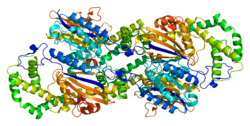Prostate-specific acid phosphatase
| Prostate-specific acid phosphatase | ||
|---|---|---|

|
||
|
Available structural data : 1CVI , 1ND5 , 1ND6 , 2HPA , 2L3H , 2L77 , 2L79 , 2MG0 , 3PPD |
||
| Properties of human protein | ||
| Mass / length primary structure | 354 amino acids; 50 kDa | |
| Secondary to quaternary structure | Homodimer | |
| Identifier | ||
| Gene names | ACPP ; ACP-3; ACP3; PAP | |
| External IDs | ||
| Enzyme classification | ||
| EC, category | 3.1.3.2 , phosphatase | |
| Response type | Saponification | |
| Substrate | Phosphoric acid (mono) ester + H 2 O | |
| Products | Alcohol + phosphate | |
| Occurrence | ||
| Homology family | acid phosphatase | |
| Parent taxon | Euteleostomi | |
| Orthologue | ||
| human | House mouse | |
| Entrez | 55 | 56318 |
| Ensemble | ENSG00000014257 | ENSMUSG00000032561 |
| UniProt | P15309 | Q8CE08 |
| Refseq (mRNA) | NM_001099 | NM_019807 |
| Refseq (protein) | NP_001090 | NP_062781 |
| Gene locus | Chr 3: 132.32 - 132.37 Mb | Chr 9: 104.29 - 104.34 Mb |
| PubMed search | 55 |
56318
|
The prostate-specific acid phosphatase (abbreviated PAP , . Of English prostatic acid phosphatase ) is a glycoprotein - enzyme , which is produced by mammals and fish. It is produced in the prostate in humans . Beyond belonging to the acid phosphatases , nothing precise is known about its function. The laboratory value proves the activity of the prostate tissue and can therefore be used as a control when it is removed.
laboratory
In diagnostics, PAP is mainly used to monitor the progression of prostate cancer . It serves here with the more important prostate-specific antigen (PSA) as a tumor marker . Since increased PAP concentrations in the blood serum are measured not only in malignant but also in benign diseases of the prostate, the PAP is regarded as an organ-specific marker and not as tumor-specific.
rating
In healthy men the concentration is less than 2.0 ng / ml in the serum. Values above 3.5 ng / ml are pathological. Persistent pathological values during therapy for prostate cancer indicate therapy failure.
Nonspecific PAP elevations in the serum occur primarily with benign prostatic hyperplasia , but also with or after manual manipulation of the prostate (palpations, catheterization) or with inflammation of the prostate.
use
Recent research also suggests that PAP could be used as a highly effective pain reliever.
Individual evidence
- ↑ Mark J. Zylka, Nathaniel A. Sowa, Bonnie Taylor-Blake, Margaret A. Twomey, Annakaisa Herrala, Vootele Voikar, Pirkko Vihko: Prostatic acid phosphatase is an ectonucleotidase and suppresses pain by generating adenosine . In: Neuron . tape 60 , no. 1 , October 2008, p. 111–122 , doi : 10.1016 / j.neuron.2008.08.024 , PMC 2629077 (free full text).
- ↑ Painkillers: the body's own protein is more effective than morphine. In: Spiegel Online . October 9, 2008, accessed April 25, 2017 .
literature
- Pschyrembel clinical dictionary , deGruyter publishing house, 256th edition
- Medical laboratory tests , laboratory Dr. Gardener, 11th edition